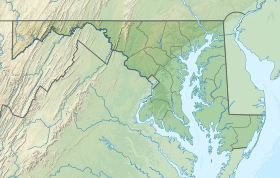| Fort Tonoloway State Park | |
|---|---|
| Location | Washington County, Maryland, United States |
| Nearest town | Hancock, Maryland |
| Coordinates | 39°41′54″N 78°12′7″W / 39.69833°N 78.20194°W |
| Area | 26 acres (11 ha)[1] |
| Designation | Maryland state park |
| Administrator | Maryland Department of Natural Resources |
Fort Tonoloway State Park is an undeveloped Maryland state park located near present-day Hancock. Fort Tonoloway was a frontier fort built in 1755 by Lt. Thomas Stoddert and men from the Maryland State Militia.[2] The fort was also known as Stoddert's Fort. It was abandoned in 1756 when Fort Frederick was constructed.[3][4]
The state park was at one time leased to the Boy Scouts. It is awaiting archaeological investigation before its use as a recreational facility can be assessed.[5]
References[edit]
- ^ "DNR Lands Acreage Report" (PDF). Maryland Department of Natural Resources. 2022. p. 8. Retrieved March 9, 2023.
- ^ "Fort Stoddert on the Tonoloways". C&O Canal Trust. Retrieved November 3, 2017.
- ^ "Tonoloway Fort". Maryland's Roadside Historical Markers. Maryland Historical Trust. Retrieved December 6, 2013.
- ^ Rubin, Mary H. (2003). The Chesapeake and Ohio Canal. Images of America. Arcadia Publishing. p. 96. ISBN 9780738515984.
- ^ "Maryland Land Preservation, Parks & Recreation Plan 2009" (PDF). Maryland Department of Natural Resources. p. 59. Retrieved December 6, 2013.
Further reading[edit]
- Tonoloway Fort: Outpost on the Maryland Frontier, Gerald Sword, Friends of Fort Frederick, 1994, ASIN: B002X49ZMA.

Well, that’s interesting to know that Psilotum nudum are known as whisk ferns. Psilotum nudum is the commoner species of the two. While the P. flaccidum is a rare species and is found in the tropical islands. Both the species are usually epiphytic in habit and grow upon tree ferns. These species may also be terrestrial and grow in humus or in the crevices of the rocks.
View the detailed Guide of Psilotum nudum: Detailed Study Of Psilotum Nudum (Whisk Fern), Classification, Anatomy, Reproduction